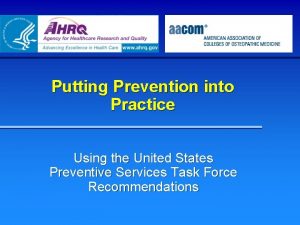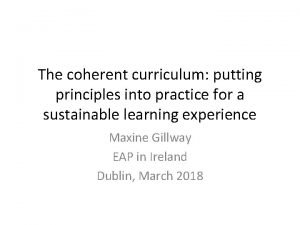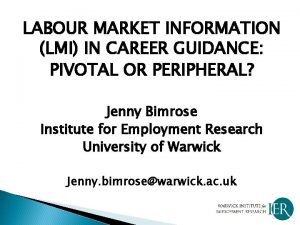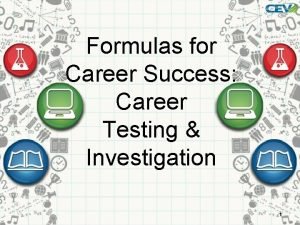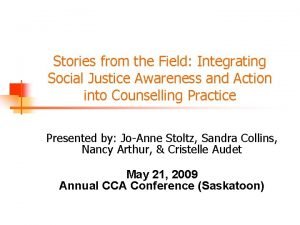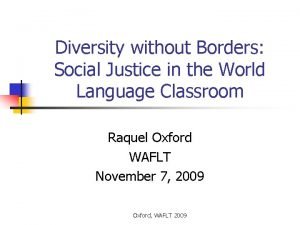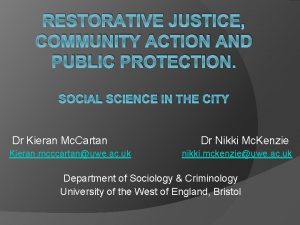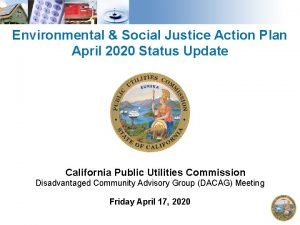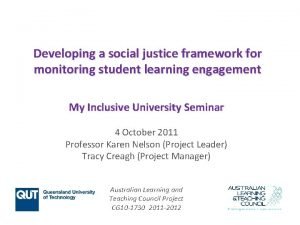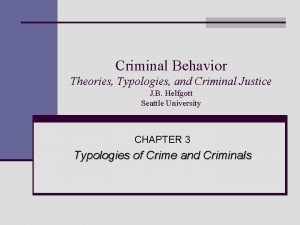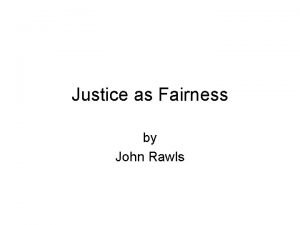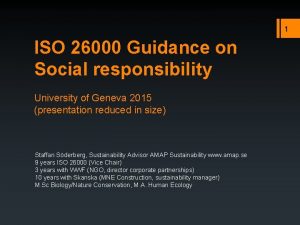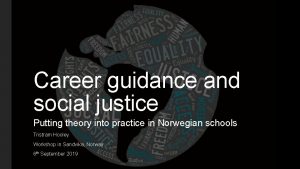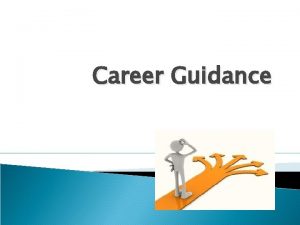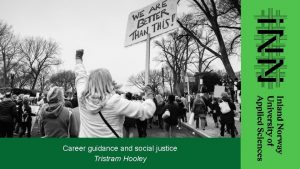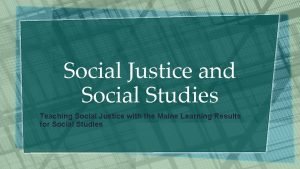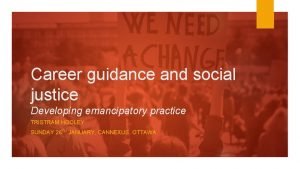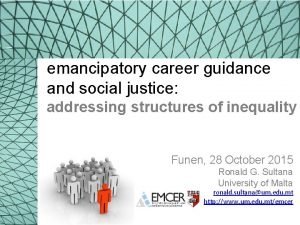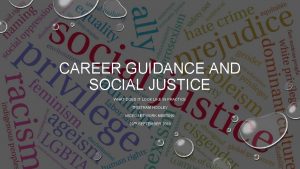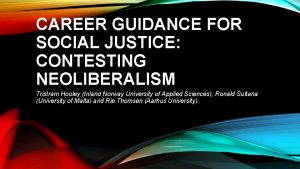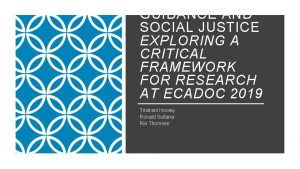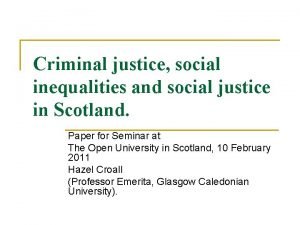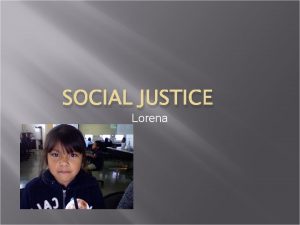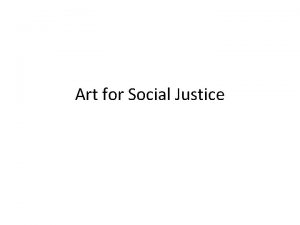CAREER GUIDANCE FOR SOCIAL JUSTICE PUTTING THEORY INTO




































- Slides: 36

CAREER GUIDANCE FOR SOCIAL JUSTICE PUTTING THEORY INTO PRACTICE Tristram Hooley NICEC/CDI Workshop, Scotland, 27 th February

The politics of career guidance Careers education and guidance is a profoundly political process. It operates at the interface between the individual and society, between self and opportunity, between aspiration and realism. It facilitates the allocation of life chances. Within a society in which such life chances are unequally distributed, it faces the issue of whether it serves to reinforce such inequalities or to reduce them. Tony Watts

How do you deal with life being unfair Discuss how you deal with when your clients raise concerns that life isn’t fair? Have you ever had a client who has… • talked about working in a job (or considering working in a job) that doesn’t pay them fairly? • been being marginalised in their life and work? E. g. feeling that they aren’t respected. • been fed up with being told what to do by their boss or colleagues? • been forced to conform to ‘norms’ by others? e. g. being told how to dress, act or behave in a way that makes them uncomfortable. • experienced aggression that makes them uncomfortable or actual physical violence?

Are these problems social or psychological? Was your advice to them social or psychological? Individual or collective?

A social justice model of guidance Reframe the concept of career more broadly Encourage people to learn about the world and build a critique of it Recognise power dynamics and be willing to discuss them. Socialise Encourage people to talk about their context and the people who matter to them. Think of social capital as a career resource. Build community capacity. Open up the possibility for collective solutions as well as individual solutions. Act Empower individually and collectively Advocate for those who can’t speak for themselves Provide feedback at a system level (notice common problems)

Overview A changing context Reframing career success Broadening LMI Understanding client experiences Rethinking career education

Overview A changing context Reframing career success Broadening LMI Understanding client experiences Rethinking career education


…AND SO?

focus on what you can control Internal/ psychology • Motivation/resilience/selfefficacy • Career management skills -s responsibilisation habitus +s Influences on our career expands possibilities External/ opportunity structure • Labour market • Education system • Politics and society fatalism

Habitus

• On your own make a list of all of the ways that you or your clients can change the opportunity structure. Asking for a pay rise or inviting an employer to your school or campus Activity Campaigning for an independent Scotland or for an increased minimum wage • Now discuss these in pairs or small groups. • How often do you raise these kinds of things with your clients?

Overview A changing context Reframing career success Broadening LMI Understanding client experiences Rethinking career education

How do you define career success?

A journey or a race?

Other dichotomies: • Personally meaningful / Employer defined • Ethical / Unconcerned • Social / Solitary • Developmental / Not requiring new learning • Safe / Dangerous There are clearly trade offs. http: //joaap. org/press/pwb/workinglife_large. jpg The exercise helps to explore what they are. It is also useful to consider why these trade offs exist in follow up exercises?

Overview A changing context Reframing career success Broadening LMI Understanding client experiences Rethinking career education

Understanding client experiences (through a social justice lens) Young’s five faces of oppression Exploitation Marginalisation Powerlessness Cultural imperialism Violence

A social justice model of guidance Reframe the concept of career more broadly Encourage people to learn about the world and build a critique of it Recognise power dynamics and be willing to discuss them. Socialise Encourage people to talk about their context and the people who matter to them. Think of social capital as a career resource. Build community capacity. Open up the possibility for collective solutions as well as individual solutions. Act Empower individually and collectively Advocate for those who can’t speak for themselves Provide feedback at a system level (notice common problems)

Act Reframe Socialise Exploitation Addressing unfair compensation and coercion. What guidance can do: • Notice, highlight and challenge issues of inequality, low pay and precarity in the labour market. • Empower individuals and groups to challenge this. Scenario: ‘I’m applying to be a Deliveroo driver. ’

Act Reframe Socialise Marginalisation Addressing loss of work, power and respect. What guidance can do about it? • Understand who is marginalised and locked out of the labour market (or of progression within it) and work to help them to re-engage. Scenario: ‘My factory closed down and now nobody wants me. ’

Act Reframe Addressing when people feel that they are always on the receiving end of orders. Socialise Powerlessness What guidance can do about it: • Help people to understand what power is and how it operates. • Encourage people to seek autonomy and self-efficacy. Scenario: ‘I’m just a ‘cog in a machine’. The school doesn’t care about me, teachers just push me around. ’

Act Reframe Socialise Addressing when people have ‘norms’ imposed on them. What guidance can do about it: • Guidance can respect difference and reaffirm pluralism. Cultural imperialism Scenario: ‘I’m a goth. Do I have to change the way that I dress to find work? ’

Act Reframe Socialise Violence Addressing random, unprovoked attacks. What guidance can do: • Challenge individual and institutional violence (advocacy) and encourage others to challenge it (empowerment). Scenario: ‘My boss keeps touching me. Should I get a new job? ’

Overview A changing context Reframing career success Broadening LMI Understanding client experiences Rethinking career education

Your use of LMI • What sources of LMI do you use? • What can LMI tell you?

Generating new kinds of LMI The big picture What do employers expect? What can you expect? • What jobs are out there? • What are the big trends? What are the counternarratives? • What are the differences in pay and opportunity? • Why are different jobs paid differently? • Is this right? • What sort of skills, aptitudes, attitudes and so on are employers looking for? • Why are these things important? • What are the upsides and downsides of becoming who they want you to be? • What do jobs pay? • Do they offer pensions? • What will I do? • What rights will I have? • Can I join a trade union? • What influence will I have over my work? • Will there be access to training? What is the impact of your work? • What am I producing? • Why? • Who is this for? • What are the political, economic, social, environmental, ethical and legal impacts of this work? This kind of list of questions can be generated collaboratively with a group. It can then offer them a framework for research.

New LMI resources • Corporate Watch https: //corporatewatch. org/ • Guardian Careers https: //www. theguardian. com/careers • Investors in People https: //www. investorsinpeople. com/ • Living wage employers https: //www. livingwage. org. uk/accredited-living-wageemployers • Resolution Foundation http: //www. resolutionfoundation. org/ • TUC blogs https: //www. tuc. org. uk/blogs

Writing an open letter Dear Corporation X We have been researching your company. Many of us would like to work for you but we have some questions about your environmental/social/political activities. XXXXXX Yours The Students of Freemantle School, Scotland Open letters like this (or other forms of campaign) can be a powerful way to engage students in researching LMI. It opens up the possibility for cross-curricular links. It also moves us into PRAXIS ie when learning, theory and practice come together.

Overview A changing context Reframing career success Broadening LMI Understanding client experiences Rethinking career education

THE POSSIBILITIES OF CAREER EDUCATION • Collaborative learning • Exploring the relationship between the self, the group and the world • Critical enquiry • Cross-curricular links • Praxis

A curriculum for how careers education can address social justice Who am I? How does the world work? Where do I fit into the world? How can I/we live with others? How do I/we go about changing the world?

References • Hooley, T. (2015). Emancipate Yourselves from Mental Slavery: Self- Actualisation, Social Justice and the Politics of Career Guidance. Derby: International Centre for Guidance Studies, University of Derby. • Hooley, T. and Barham, L. (Eds. ). (2015). Career Development Policy and Practice: The Tony Watts Reader. Stafford: Highflyers. • Hooley, T. and Sultana, R. (2016). Career guidance for social justice. Journal of the National Institute for Career Education and Counselling, 36, 2 -11. • Hooley, T. , Sultana, R. and Thomsen, R. (2018). Career Guidance for Social Justice: Contesting Neoliberalism. London: Routledge. • Law, B. (2012). The uses of narrative: Three scene storyboarding – learning for living, http: //www. hiho. com/storyboarding/sb. L 4 L. pdf. • Precarious Workers Brigade. (2017). Training for Exploitation? Politicising Employabiity & Reclaiming Education. London/Leipzig/Los Angeles: Journal of Aesthetics and Protest Press. • Young, I. M. (1990) Five Faces of Oppression, in Justice and the Politics of Difference, Princeton, NJ: Princeton University Press, 39 -65.

A social justice model of guidance Reframe the concept of career more broadly Encourage people to learn about the world and build a critique of it Recognise power dynamics and be willing to discuss them. Socialise Encourage people to talk about their context and the people who matter to them. Think of social capital as a career resource. Build community capacity. Open up the possibility for collective solutions as well as individual solutions. Act Empower individually and collectively Advocate for those who can’t speak for themselves Provide feedback at a system level (notice common problems)

This is just the start • I’ve tried to offer some ideas about what a more radical version of career guidance could look like. • I’ve also tried to encourage you to have some discussions and generate some further ideas. • We need to keep experimenting, discussing and writing about these things.

Tristram Hooley Professor of Career Education International Centre for Guidance Studies University of Derby http: //www. derby. ac. uk/icegs t. hooley@derby. ac. uk @pigironjoe Blog at http: //adventuresincareerdevelopment. wordpress. com
 Physical and non-physical rate fences
Physical and non-physical rate fences Oncology nursing society putting evidence into practice
Oncology nursing society putting evidence into practice Putting the enterprise into the enterprise system
Putting the enterprise into the enterprise system Putting the enterprise into the enterprise system
Putting the enterprise into the enterprise system Putting it into practice
Putting it into practice Putting prevention into practice
Putting prevention into practice Coherent curriculum
Coherent curriculum Incisal guidance in complete denture
Incisal guidance in complete denture What is direct and indirect guidance
What is direct and indirect guidance Ecg career guidance
Ecg career guidance History of counseling in the philippines timeline
History of counseling in the philippines timeline Conceptualisatio
Conceptualisatio Career guidance presentation
Career guidance presentation Career guidance training
Career guidance training Ocr level 6 diploma in career guidance and development
Ocr level 6 diploma in career guidance and development Proposal writing on career guidance workshop
Proposal writing on career guidance workshop National career clusters
National career clusters Formulas for career success
Formulas for career success Colette bennett
Colette bennett Immigrant definiton
Immigrant definiton Social justice approach
Social justice approach Pdhpe ottawa charter
Pdhpe ottawa charter Social justice awareness
Social justice awareness Social justice essential questions
Social justice essential questions Restorative justice community action
Restorative justice community action Cpuc esj action plan
Cpuc esj action plan Principle of social justice
Principle of social justice John rawls theory of justice
John rawls theory of justice Behavioral theory in criminal justice
Behavioral theory in criminal justice Veil of ignorance meaning
Veil of ignorance meaning Conflict theory criminal justice
Conflict theory criminal justice Apa itu social thinking
Apa itu social thinking Social thinking social influence social relations
Social thinking social influence social relations Iso/iec 26000:2010 – social responsibility
Iso/iec 26000:2010 – social responsibility Putting-out system
Putting-out system What does nasreen say about ice cream with chocolate
What does nasreen say about ice cream with chocolate Putting-out system
Putting-out system





